- 1Department of Energy Resources Engineering, Stanford University, Stanford, CA, United States
- 2Chevron Technical Center, San Ramon, CA, United States
Data-space inversion (DSI) is a data assimilation procedure that directly generates posterior flow predictions, for time series of interest, without calibrating model parameters. No forward flow simulation is performed in the data assimilation process. DSI instead uses the prior data generated by performing
Introduction
Traditional model-based history matching entails the calibration of model parameters such that flow predictions match observed data, to within some tolerance. History matching, also referred to as data assimilation, represents an essential component of the overall reservoir management workflow, because without this calibration, predicted reservoir performance can be highly uncertain. Although model-based history matching approaches are well developed and widely applied, there are still some outstanding issues surrounding their characteristics and use. These include high computational demands, challenges associated with providing history matched (posterior) models that are fully consistent geologically with prior models, and lack of formal guarantees regarding posterior sampling.
Complementary approaches, referred to as data-space inversion procedures, have been developed in recent years. These methods do not provide posterior models but rather posterior predictions for key time-series of interest, such as well or field injection and production rates. Although their inability to generate posterior models represents a limitation in some application areas, DSI procedures have advantages over model-based methods in other settings. These include the ability to consider prior realizations from a range of different scenarios, decreased computational demands (in many cases), and flexibility in terms of data error and data weighting specifications. Data-space methods are commonly applied in conjunction with a data parameterization procedure. This allows data from prior realizations to be represented concisely and, ideally, assures that posterior data predictions (well-rate time series) display the correct physical character.
In recent work, we introduced a new data parameterization procedure and incorporated it into the DSI framework. This approach entails the use of a recurrent autoencoder in combination with a long short-term memory (LSTM) recurrent neural network. This treatment was shown to outperform existing approaches, including the use of principal component analysis with histogram transformation, and the direct use of time-series data without parameterization, for a set of idealized test cases. In this paper, we will explore the properties and behavior of this RAE-based parameterization for a complicated case based on an actual naturally fractured reservoir. We will, in particular, assess the ability of the new parameterization method to capture key correlations in the time-series production data. Accurately capturing such correlations is important for computing so-called derived quantities (i.e. quantities such as water cut that are constructed by combining data from one or more time series treated directly in DSI), and for quantifying uncertainty reduction when observations involve data of different types.
The basic DSI method applied here was originally developed by [1, 2]. DSI is formulated within a Bayesian framework, and different posterior sampling methods have been applied. In the original implementation [1–3], the randomized maximum likelihood method was used. Recent work by [4] demonstrated the advantages of ensemble smoother with multiple data assimilation (ESMDA) for posterior sampling. ESMDA was also found to perform well with our deep-learning-based DSI method [5].
A number of other methods that share some similarities with DSI have also been proposed. These include the prediction focused method originally developed by [6]. This approach entails the construction of a statistical relationship between observed data and the prediction objective in the parameterized latent space. Multivariate kernel density estimation [6], canonical correlation analysis [7–9], and artificial neural network with support vector regression [10] have been applied to build the relationship between observations and predictions in the low-dimensional space. When the latent space is not of very low dimension, however, these approaches may have difficulty capturing nonlinear data. The ensemble variance analysis (EVA) method developed by [11] represents another type of data-space method. This approach entails the construction of the cumulative distribution function for posterior results under a multi-Gaussian assumption. In [12], a nonlinear generalization of EVA was developed by applying nonlinear simulation regression with localization. EVA-based procedures, however, treat the various quantities of interest (QoI) individually, and thus do not fully capture the correlations between different QoI. In addition, they are not designed to provide time-series forecasts.
Data-space (and related) methods often apply some type of parameterization to provide a low-dimensional representation of the time-series data. Such a parameterization should, ideally, capture the complex physical behavior of, and correlations between, the various data streams. In [9, 10, 13], PCA was applied directly for dimension reduction and parameterization. PCA has also been combined with specialized mappings for time-series data with particular (problem-specific) characteristics [1]. This treatment was later generalized to a PCA procedure combined with histogram transformation, which was applied to noisy data resulting from multiple operational stages [2]. Nonlinear PCA [6] and functional data analysis methods [7, 8] have also been used to parameterize data from tracer flow and oil reservoir production problems. Recently, deep-learning based methods for time-series data, including auto-regressive [14] and recurrent neural network [15] treatments, were developed for reservoir forecasting. As noted earlier, our previous work entails the use of an LSTM-based RAE [5], which was shown to capture important correlations in time-series data.
A key goal of this work is to assess the performance of our new DSI treatments, previously demonstrated only for idealized cases, in a complicated real-field setting. The models considered here derive from an actual naturally fractured reservoir, though the operational specifications used in our examples represent one out of several possible scenarios. The field has over 10 years of primary production history, and a multiyear waterflood pilot involving two injectors with tracers is currently being planned to evaluate water injection as a potential full-field improved oil recovery (IOR) strategy. In this study, a large set of prior models (1850) is generated and simulated using an efficient workflow [16]. These models are based on nine discrete fracture network realizations and a range of matrix and fracture parameters (e.g. permeability, porosity, and rock compressibility). As a result of the multiple development stages considered, complex flow physics, and field-management logic (necessary for water and gas processing), the time-series data are quite complicated. Thus, this case represents a challenging test for the RAE-based parameterization. In this study, we are particularly interested in assessing the ability of the new parameterization to capture correlations in the waterflood pilot and full-field water injection forecasts, since pilot surveillance data will be used as indicators for future field performance [17]. It is important to note, however, that we do not use actual production data in our assessments here, but rather synthetic data. These data are derived from simulations of randomly selected realizations not used in the construction of the parameterizations. This approach enables us to avoid data-confidentiality issues and, importantly, allows us to assess DSI performance for multiple “true” models.
This paper proceeds as follows. In Section 2, we provide a concise review of the two data parameterization methods considered in this study and the overall DSI procedure. In Section 3, we describe the field and the models, and present results for the reconstruction of new (prior) data realizations not used in training. Correlations between data of different types will be considered. Posterior DSI predictions for primary and secondary quantities are presented in Section 4. Conclusion and suggestions for future work are provided in Section 5.
Data Parameterization and Data-Space Inversion
In this section, we first provide a review of the two data parameterization methods considered in this work–principal component analysis with histogram transformation (HT) [2], and the recurrent autoencoder procedure [5]. The use of these parameterizations in the DSI framework is then discussed.
Parameterization of Time-Series Data
In DSI, we use prior realizations of time-series data in combination with observed data to construct posterior data realizations. The generation of the prior data vectors, which is the time-consuming step in DSI, is accomplished by simulating a relatively large number (typically
The generation of the prior ensemble of data vectors
where
The data vectors typically follow high-dimensional non-Gaussian distributions as a result of the strongly nonlinear forward simulation process and the heterogeneous property fields that characterize the geomodels. Data parameterization enables us to use low-dimensional latent variables,
PCA With Histogram Transformation
Sun et al. [2] applied PCA with histogram transformation for the parameterization of noisy data. This approach is straightforward to use and it preserves the marginal distributions of the individual data variables, but it does not in general capture the correlations between different data variables (including correlations in time for a single QoI). The basic approach is as follows. The PCA basis matrix is constructed by performing singular value decomposition (SVD) of the data matrix
where
With the PCA mapping, the latent-space prior vectors
where
As noted earlier, because histogram transformation for each component of
RAE Procedure
The RAE-based time-series parameterization introduced by [5] involves an autoencoder and a long short-term memory (LSTM) network. The basic RAE architecture is shown in Figure 1. The encoder portion of the RAE maps the time-series data d to the low-dimensional latent variables
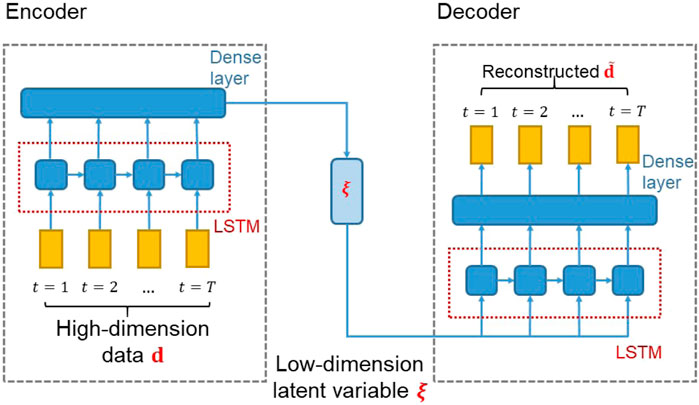
FIGURE 1. Schematic of RAE architecture (figure modified from [5]).
LSTM architectures, introduced by [18], are recurrent neural networks designed to capture both long-term and short-term information in time-series data. The LSTM unit for each time step t is composed of a neural network cell to store the temporal dynamics and three gates to regulate the input and output information. Let
where
The candidate new cell state
The cell state
where
The LSTM network is combined with an autoencoder to parameterize the time-series data. In the encoder component, LSTM is applied to map the high-dimensional data to the latent space variable, here designated
where
For the decoder component, LSTM is applied to map the latent space variable
where
A supervised-learning procedure is used to train the RAE network. The training loss is defined as the root mean square error (RMSE) between the normalized prior simulation data
where N denotes the number of samples used for training. We apply the adaptive moment estimation (ADAM) algorithm [19] in the training process to determine the parameters
DSI With Parameterized Data
As noted previously, in the DSI procedure, we first generate an ensemble of prior data vectors
where matrix
In DSI with parameterized data, we perform inversion on the latent space variable
An underlying assumption of this representation is that the prior distribution of
for
At each iteration k, we update the ensemble of historical-period data
We resample the observed data by adding random noise
Most of our treatments here are identical to those in our earlier work [5], though there is one important difference in the ESMDA procedure. In [5], because our goal was to compare DSI results to reference rejection sampling results, we had only a small number of observations
We now briefly summarize the overall DSI procedure with data parameterization and ESMDA for posterior sampling. First, an ensemble of prior models
Model Setup and Prior Reconstruction
In this section, we first describe the geomodels and simulation settings used to model the naturally fractured reservoir considered in this work. We then present detailed results for prior-data reconstruction using the two parameterization procedures described in Section 2.
Fractured Model Setup
We consider a challenging waterflooding problem that involves three-phase flow in a real light-oil reservoir. The carbonate reservoir comprises heterogeneous matrix rocks that are highly fractured in some regions, especially in tight facies. The natural fractures strongly impact flow behavior. We account for geological uncertainty using an ensemble of 3D embedded discrete fracture models (EDFMs). The realizations are based on nine stochastic discrete fracture networks (DFNs), shown in Figure 2. These nine DFNs are intended to ‘span’ the range of uncertainty in the spatial variability and connectivity of the fracture system. Please see [16] for a more detailed description of the workflow used to grid and simulate the ensemble of EDFMs.
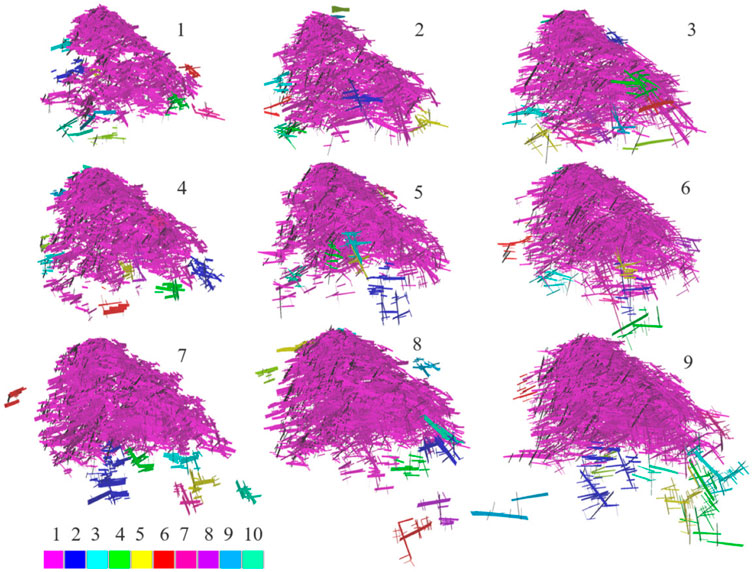
FIGURE 2. EDFMs representing uncertainty in fracture networks of the real carbonate reservoir. Color bar displays cluster size, with pink being the largest. Only cells belonging to the 10 largest clusters are shown; isolated cells are not displayed (figure from [16]).
In addition to the different DFNs, three model properties (fracture permeability, fracture pore volume, and matrix permeability) are varied through use of three categorical global multipliers (low, mid, and high) to capture their ranges of uncertainty. There is considerable variability in these properties, e.g., matrix permeabilities are on the order of 0.1 mD, while fracture permeabilities can be a factor of
One model parameter, fracture pore volume, warrants additional elaboration because we will consider a value beyond its prior range when we apply DSI in Section 4. Fracture pore volume is a function of the heterogeneous distribution of fracture apertures, which themselves range from less than 1 mm to greater than 1 m. This latter value, which is much higher than that observed in typical fractured reservoirs, accounts for the existence of “caverns” in the carbonate formation. The fracture pore volume strongly impacts the amount of recoverable oil in the reservoir, so its value has a large effect on reservoir performance.
A total of
The simulations capture three field stages: part of the primary depletion period with 11 existing producers (2.5 years), followed by a five-year water-injection pilot, and finally the large-scale full-field waterflood development that lasts for 17.5 years. Note that we did not consider the actual full depletion period (14 years) in order to have a more typical ratio of historical period (3,600 days) to forecast period (5,400 days). During the pilot period, two wells inject water at a target rate subject to a maximum bottom-hole pressure (BHP), while the existing producers operate at prescribed target oil rates subject to minimum BHP constraints. Injected water contains different tracers (referred to as A and B) that can be detected at nearby producers. Breakthrough time, for example, is one of several pilot indicators measured to assist in predicting future full-field waterflood performance (water breakthrough is expected to be controlled in part by fracture connectivity, which impacts sweep efficiency [17]). Three new producers will be introduced into the model during the pilot period.
At the start of the full-field development phase, an additional four injectors and three producers are drilled. The total water-injection rate for the six injectors is controlled to achieve a target voidage replacement ratio. The reservoir pressure drops below the bubble point at some point during this stage, leading to the evolution of free gas. The resulting three-phase flow is one of several simulation challenges. For example, the producers are subject to many other constraints such as tubing head pressure (controlled by flow tables as a proxy for surface network dependencies), as well as maximum gas/oil ratio and watercut due to plant-handling capacities for water and gas. As a result, wells are shut-in and revived frequently based on a complicated set of field-management rules. This leads to “spiky” well production and injection behavior, which in turn poses significant challenges for the parameterization procedures.
The flow simulations are also difficult because the reservoir models contain many stratigraphic layers that pinch-out, which can lead to small cells (especially fracture cells) that limit the time-step size. This is partly ameliorated by the EDFM gridding, which enforces a lower bound on fracture cell size, as well as by the upscaling. The overall workflow requires on average about 10 min per model for gridding and i/o, and 2.0 h for simulation (in parallel, with 16 processors on 64-bit LINUX clusters equipped with 2x AMD EPYC 7502 32-Core Processor with 512 GB of memory). The additional computational effort required by the DSI procedure (for parameterization and posterior sampling) is essentially negligible compared to that for generating the prior data realizations.
Reconstruction of Prior Data With PCA and RAE
Although our eventual goal is the use of the data parameterization treatments for data-space inversion, it is important to first assess the ability of the two methods to reconstruct new data realizations; i.e., prior data vectors not included in training. As is evident from the discussion in Section 2.2, ESMDA is applied to the latent variable
In this study, we construct parameterizations and apply DSI only for selected field-wide and well-level QoI. Specifically, we model water injection rates (WIR) for the field and for pilot injectors I1 and I2, as well as the water production rates (WPR) and oil production rates (OPR) for the field and for four of the 14 producers (P1–P4). These producers are deemed to be the most promising for tracer detection during the pilot due to their proximity to I1 and I2. We also include the tracer A production rate (TAR) for the field and for wells P2 and P4, and the tracer B production rate (TBR) for the field and for wells P1 and P3. The final quantities considered are the static well pressures (SWP) for all injectors and producers. In total, there are 25 QoI, i. e,
We simulate a total of
We preserve 99% of the energy in the construction of the PCA basis matrix. This results in
Before considering prior-data reconstruction, we present results for RAE training and testing performance. The evolution of RAE training and testing error (RMSE is defined in Eq. 10) with varying numbers of epochs, for

FIGURE 3. RAE error evolution during training and RAE error with different numbers of training samples.
Figure 3B shows the training and testing RMSE, with different numbers of training samples, at the end of 500 epochs. Note “training samples” refers to both data realizations used for the actual loss function minimization and data realizations used for testing during the training procedure. Here we again use a training/testing split ratio of around 4.5/1. Increasing the number of training samples generally decreases the training and testing RMSE, as expected, though the results approach a plateau by
Results for the reconstruction of prior data realizations are now presented. We show results drawn from the set of
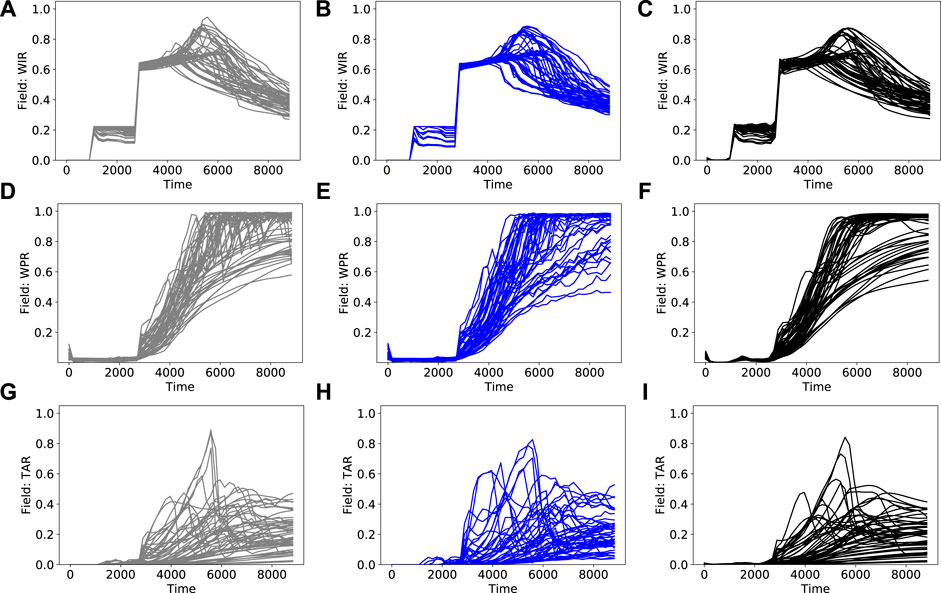
FIGURE 4. Prior simulation results (left column), PCA+HT reconstructions (middle column) and RAE reconstructions (right column) for field-wide quantities (A)–(C) field-wide water injection rate (D)–(F) field-wide water production rate (G)–(I) field-wide tracer A production rate.
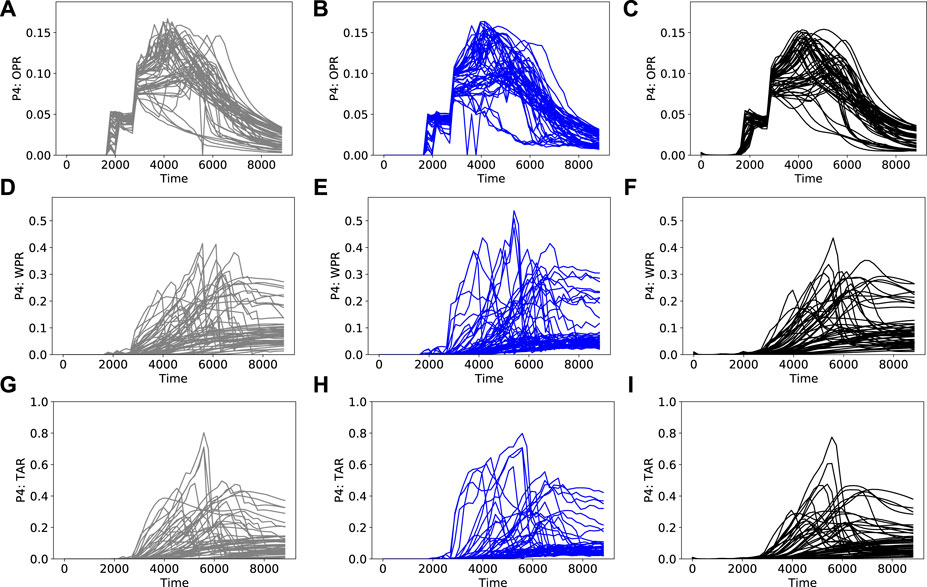
FIGURE 5. Prior simulation results (left column), PCA+HT reconstructions (middle column) and RAE reconstructions (right column) for well P4 quantities (A)–(C) P4 oil production rate (D)–(F) P4 water production rate (G)–(I) P4 tracer A rate.
Figure 4 shows the clear ramp-up of field water injection rate as more injectors come online after the end of the pilot (around 2,700 days). The corresponding rise in water production rate is also apparent. Eventually, the field water injection rate drops. This occurs after the field liquid production rate reaches a peak, in accordance with the voidage-replacement-ratio specification (required to be less than 1). In Figure 5, we see that, in some cases, P4 tracer A production rate increases and then decreases. This is due to dilution from tracer-free water from injectors that are drilled after the pilot ends. In other cases, where I1 remains the main source of water, the P4 tracer A production rate continually increases.
The simulation results are complex due to frequent changes in well operations resulting from the field management logic. Abrupt variations in the reference simulation results are evident in many of the curves, particularly in Figures 5D,G (and to some extent in Figure 4G). The PCA+HT reconstruction results are in general agreement with the prior simulation results, but they do show noticeable overprediction in some cases, at around 3,000–5,000 days, in Figure 4H and Figures 5E,H. Some higher-frequency oscillation compared to the reference results, particularly in Figure 4E and Figure 5E, is also apparent. These oscillations occur because, as discussed previously, time correlations are not maintained with this approach.
The RAE reconstructions in Figures 4 and 5 are in better visual agreement with the reference prior results than the PCA+HT reconstructions. More specifically, the overprediction and oscillatory behavior evident in some of the PCA+HT results does not occur in the RAE reconstructions (e.g. compare Figures 5E,F). Interestingly, the RAE results tend to be slightly smoother than the reference results. Although this may actually be desirable in some settings, such smoothing can in general be mitigated by increasing the latent-space dimension and/or using a more complex network.
We now assess the performance of the reconstructions for derived quantities. By derived quantity, we mean QoI not directly included in
Figure 6 displays prior simulation results and reconstruction results for P4 water cut, P4 liquid production rate, and field-wide liquid production rate. In Figures 6B,E, we see a high degree of nonphysical oscillations in the PCA+HT results. Capturing the correct behavior of derived quantities such as water cut is important because it has implications for the field development plan (e.g. on the timing for additional water-handling capacity). The RAE reconstructions, by contrast, display close agreement with the reference prior simulation results. This suggests that, consistent with our earlier findings for much simpler systems [5], the RAE parameterization is able to capture correlations more accurately than the PCA+HT treatment for this complicated case.
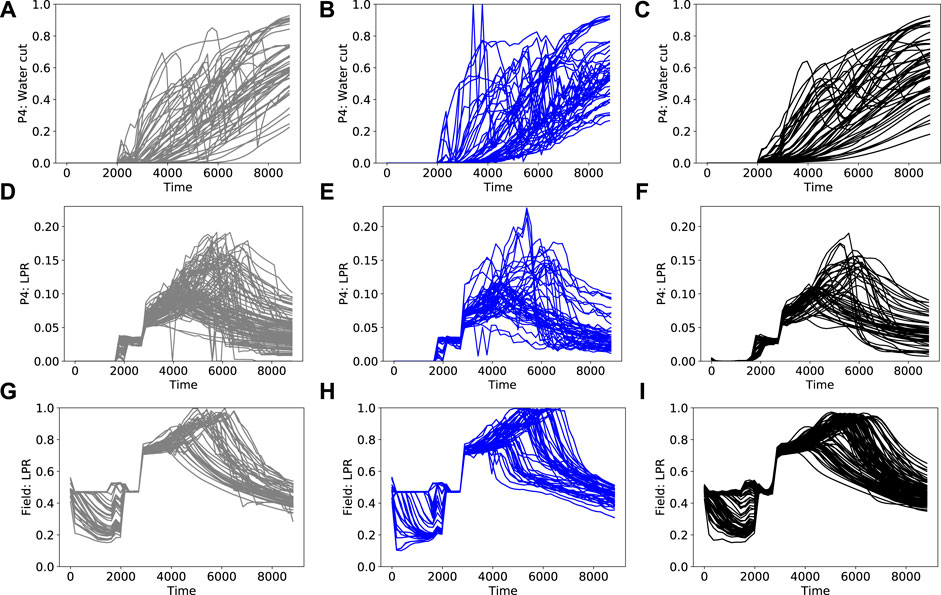
FIGURE 6. Prior simulation results (left column), PCA+HT reconstructions (middle column), RAE reconstructions (right column) for derived quantities (A)–(C) P4 water cut (D)–(F) P4 liquid production rate (G)–(I) field-wide liquid production rate.
We now further assess the ability of the two parameterizations to capture correlations in the prior simulation data. This will be evaluated both visually, through cross-plots, and in terms of the covariance between sets of quantities. For two quantities x and y, covariance is given by
where
Figures 7–10 show cross-plots for different primary and derived quantities at 8,280 days, along with the covariance between the two time series. In these plots, results for all
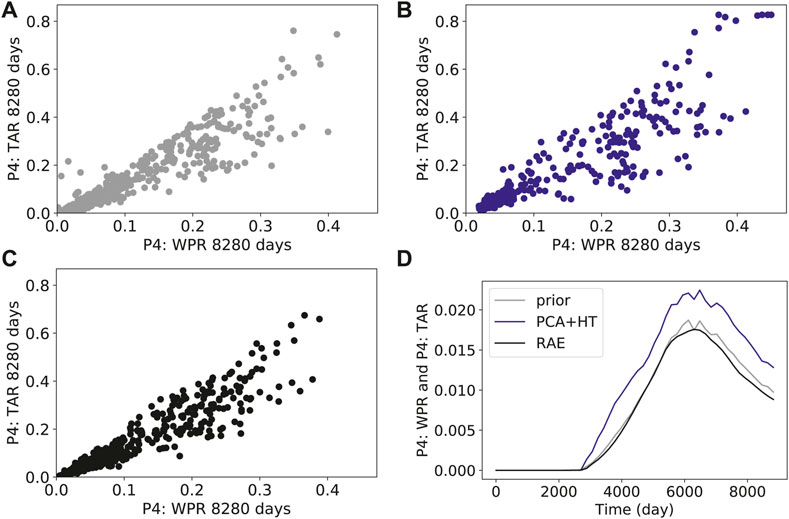
FIGURE 7. Cross-plots and covariance curves for tracer A production rate in well P4 and water production rate in well P4 (A) prior simulation results (B) PCA+HT reconstructions (C) RAE reconstructions (D) covariance.
Figures 8–10 present cross-plots and covariance curves for three different sets of derived quantities. Figure 8 displays results for cumulative production of tracer B at well P1 against cumulative water production for well P1, Figure 9 shows results for well P4 water cut against well P4 oil production rate, and Figure 10 presents results for field-wide cumulative liquid production against field-wide cumulative water injection. The linear trends evident in Figure 10 are reflective of the voidage-replacement control in field-wide injection, while the separation into three clusters reflects the three different rock-compressibility curves considered (see Section 3.1). In all cases, we observe better agreement with the reference simulation results with the RAE reconstruction than with the PCA+HT reconstruction. This is evident in all of the covariance plots, and in the ranges and character of the cross-plots. For example, the range of the prior is better captured in Figure 8C than in Figure 8B, and the continuity and linear character of the upper cluster of points is better captured in Figure 10C than in Figure 10B.
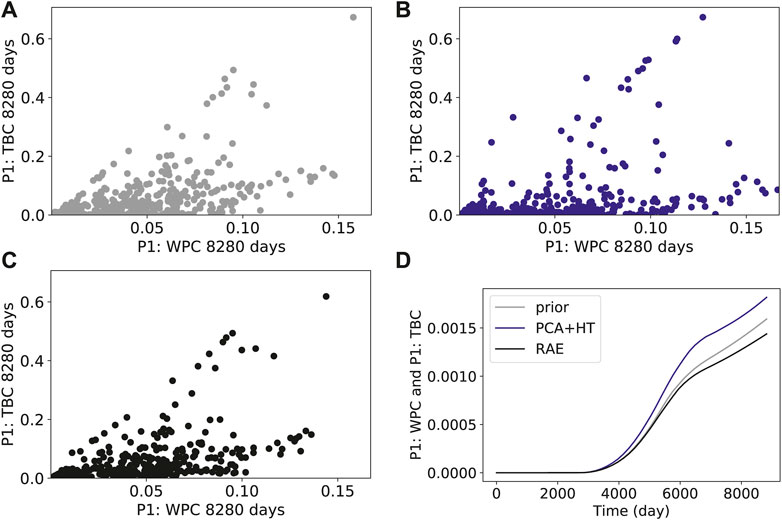
FIGURE 8. Cross-plots and covariance curves for tracer B cumulative production in well P1 and cumulative water production in well P1 (A) prior simulation results (B) PCA+HT reconstructions (C) RAE reconstructions (D) covariance.
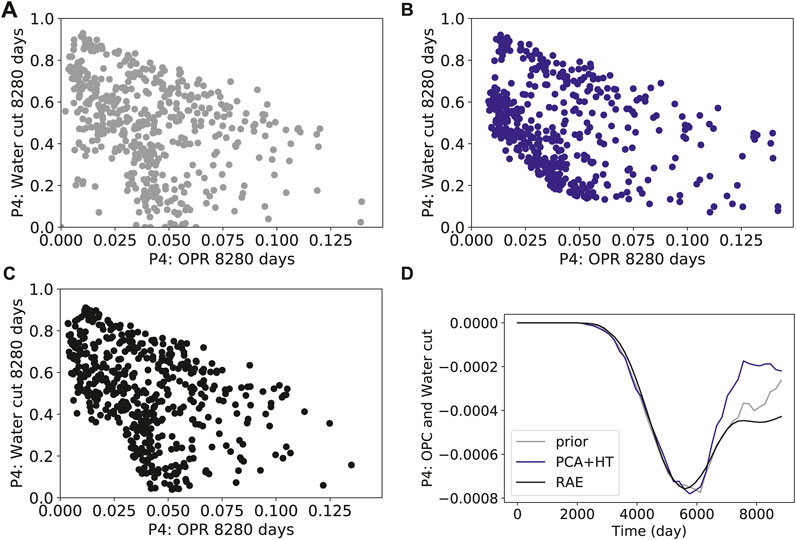
FIGURE 9. Cross-plots and covariance curves for water cut in well P4 and oil production rate in well P4 (A) prior simulation results (B) PCA+HT reconstructions (C) RAE reconstructions (D) covariance.
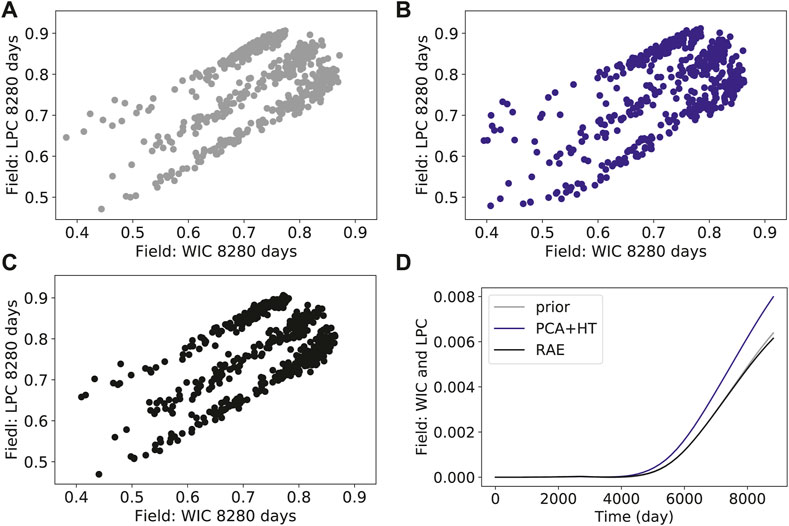
FIGURE 10. Cross-plots and covariance curves for field-wide cumulative liquid production and field-wide cumulative water injection (A) prior simulation results (B) PCA+HT reconstructions (C) RAE reconstructions (D) covariance.
Posterior Predictions Using DSI
We now assess DSI posterior results using the two parameterization procedures. Although the reservoir models considered in this study are used for actual field modeling, the field data are confidential and thus not available for use in our assessments. We therefore utilize simulated data as described earlier. The “synthetic” nature of the data is partially mitigated through the addition of random noise (see Eq. 11). To further “stress-test” the DSI framework, in the first assessment (in Section 4.1) we generate synthetic data from a true model that is characterized by a key model parameter that is outside the prior range. Specifically, we assign this true model a fracture pore volume that is 1/2 of the lowest value used in the prior ensemble. Importantly, although the model itself is outside the prior, the data still fall within the prior data range. Because the prior range in this work is much broader than that often considered in history matching studies (recall we consider nine DFN realizations coupled with wide ranges for other key parameters), the requirement that the data lie within the prior range is not an overly limiting constraint.
We note finally that a general correspondence between the observed data and the prior simulation results should be established in an initial prior-validation step. This can be accomplished, for example, through use of the Mahalanobis distance, as described within a DSI context in [24]. If the data fall well outside the prior range, then the prior must be extended before DSI, or any other inversion procedure, is applied. Although important in practice, we view the prior-validation step as outside the scope of this study.
In all cases considered, the observed data (generated from simulation results for the true model with noise added, as described in Section 2.2) include values for all primary quantities at 900, 1800, 2,700 and 3,600 days. The number of observed data values (
In Section 4.1, we present detailed DSI results, with both parameterizations, for true model 1. Then, in Section 4.2, we consider the representation of DSI posterior data predictions (for true model 1) in terms of linear combinations of prior data realizations. In Section 4.3, DSI performance for five additional true models is assessed through use of coverage probability metrics.
DSI Results for True Model 1
As indicated above, the fracture pore volume for true model 1 lies outside of the prior range, while the other model parameters fall within the prior range. Posterior results for three field-wide primary quantities–water injection rate, water production rate, and tracer A production rate–are shown in Figure 11. Additional results for primary quantities for well P4–oil production rate, water production rate, and tracer A production rate–appear in Figure 12. In the figures, the gray-shaded regions indicate the
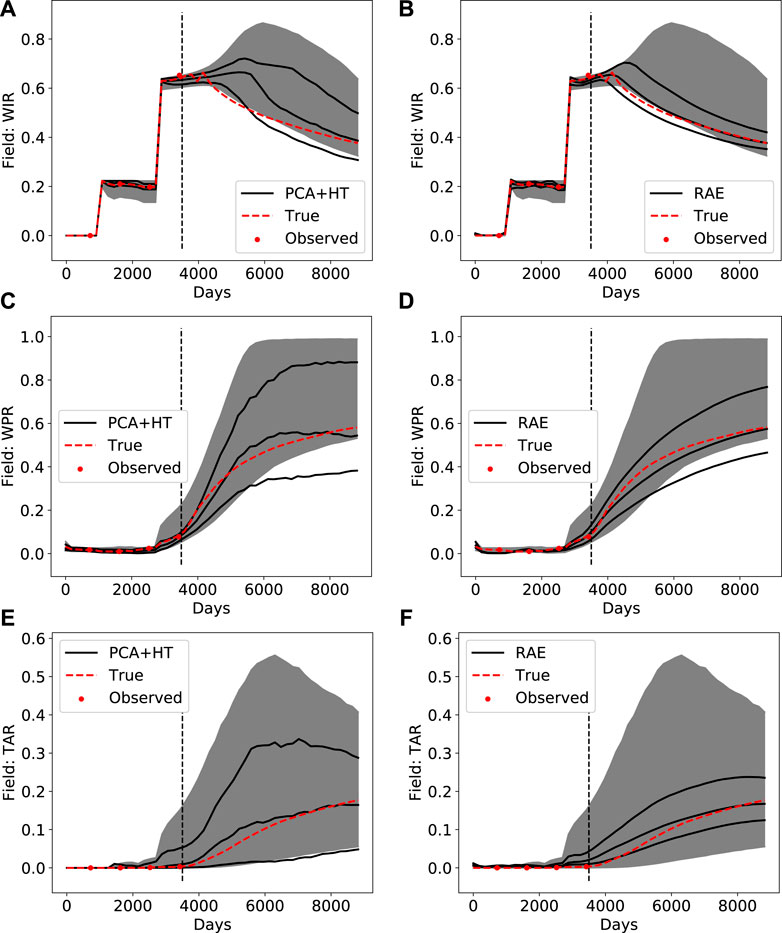
FIGURE 11. Posterior DSI results using PCA+HT parameterization (left column) and RAE-based parameterization (right column) for (A) and (B) field-wide water injection rate (C) and (D) field-wide water production rate (E) and (F) field-wide tracer A production rate.
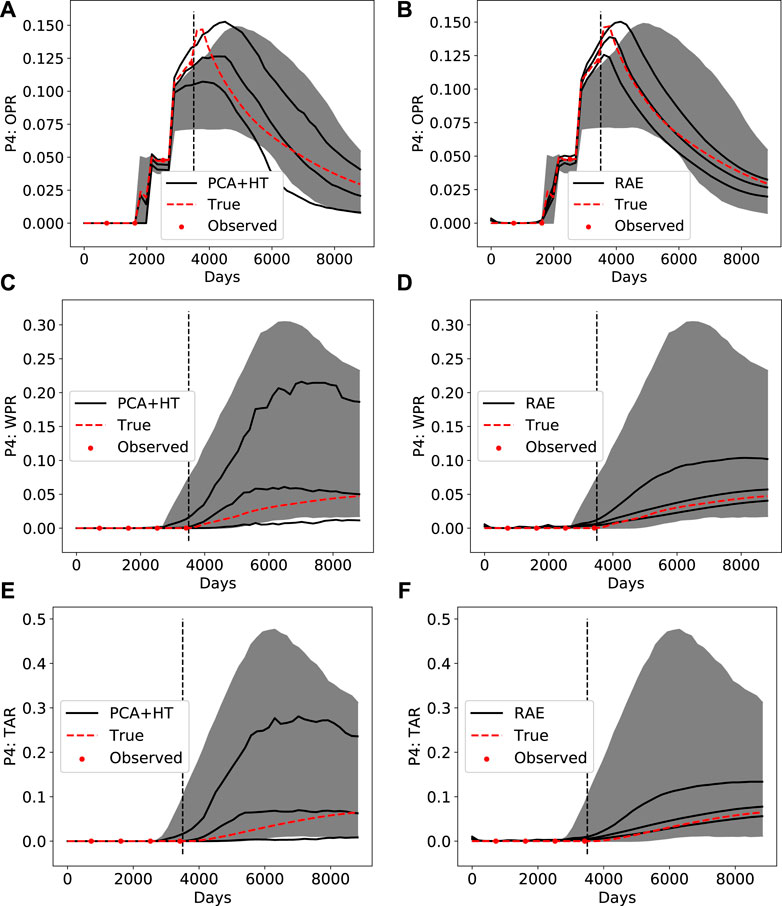
FIGURE 12. Posterior DSI results using PCA+HT parameterization (left column) and RAE-based parameterization (right column) for (A) and (B) P4 oil production rate (C) and (D) P4 water production rate (E) and (F) P4 tracer A rate.
We see that more uncertainty reduction is accomplished using RAE-based DSI than with the PCA+HT treatment. This is evident through comparison of all posterior results in Figure 11 and Figure 12. The general shape of the true response is also better captured by RAE, as can be seen by comparing Figure 11B to Figure 11A, and Figure 12B to Figure 12A. The true response is within the
Figure 13 displays posterior results for three derived quantities–well P4 water cut, well P4 liquid production rate, and field-wide liquid production rate. We again see a greater amount of uncertainty reduction with RAE-based DSI than with the PCA+HT treatment. This is particularly noticeable in the liquid production rate results for both well P4 and for the full field. Note that, because the true model is outside of the prior, the field-wide liquid production rates in Figures 13E,F are below the

FIGURE 13. Posterior DSI results using PCA+HT parameterization (left column) and RAE-based parameterization (right column) for derived quantities (A) and (B) P4 water cut (C) and (D) P4 liquid production rate (E) and (F) field-wide liquid production rate.
Next, we consider correlations between posterior quantities for the two parameterization methods. Figures 14 and 15 display cross-plots for primary and derived quantities. The corresponding prior results appear in Figures 7–10. The gray points in the left column display the prior simulation results (for all 1850 prior samples), the blue points in the middle column show DSI results using the PCA+HT parameterization, and the black points in the right column are DSI results using the RAE-based parameterization. The gray points in the background in the middle and right columns are the prior simulation results (these points are the same as in the plots in the left column). The red points depict the true data.
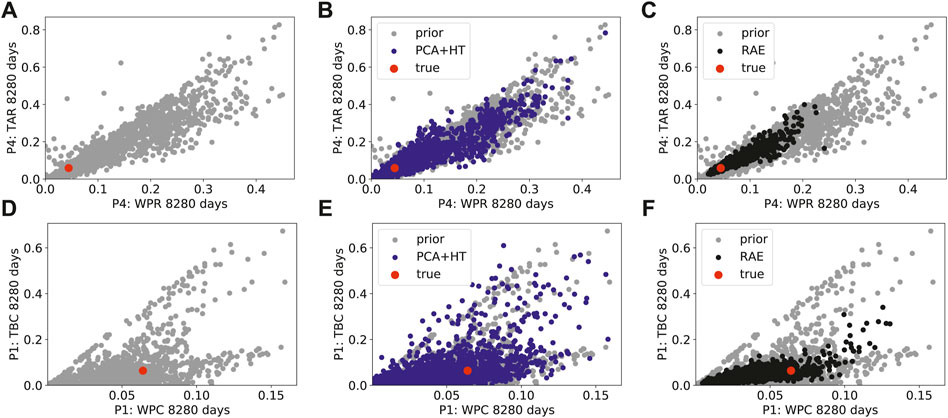
FIGURE 14. Cross-plots for prior simulation results (left column), posterior DSI results using PCA+HT parameterization (middle column) and posterior DSI results using RAE-based parameterization (right column) (A)–(C) P4 tracer A production rate against P4 water production rate (D)–(F) P1 tracer B cumulative production against P1 cumulative water production.
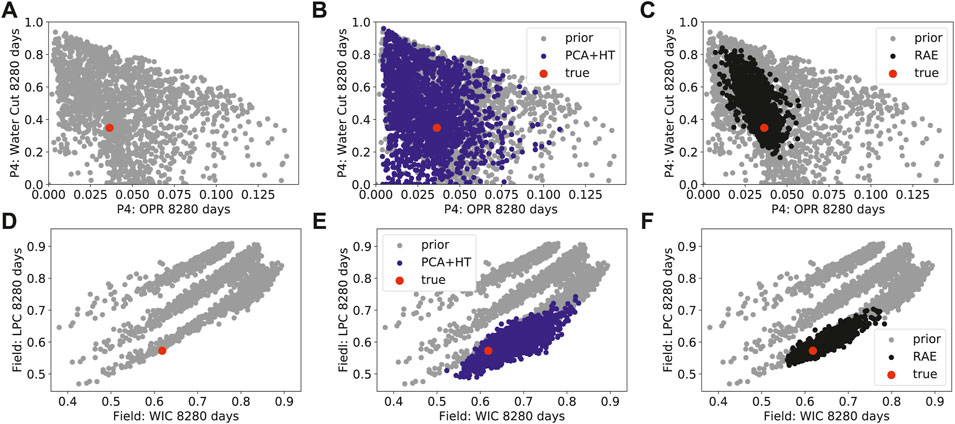
FIGURE 15. Cross-plots for prior simulation results (left column), posterior DSI results using PCA+HT parameterization (middle column) and posterior DSI results using RAE-based parameterization (right column) (A)–(C) P4 water cut against P4 oil production rate (D)–(F) field-wide cumulative liquid production against field-wide cumulative water injection.
These figures again demonstrate the increased uncertainty reduction achieved using the RAE-based parameterization in DSI relative to that using the PCA+HT parameterization. In Figure 14B, with the true data point falling near the (lower-left) edge of the prior data, we see very little uncertainty reduction with PCA+HT. In the RAE-based result (Figure 14C), by contrast, a reasonable degree of uncertainty reduction is achieved. Similar observations can be made between Figures 14E,F, and between Figures 15B,C.
In this assessment, it is important to capture correlations between key data quantities to obtain accurate estimates of the expected uncertainty reduction in the main QoI. For example, by collecting indicator data such as P4 tracer production rate (Figures 12E,F), we can potentially gain insight regarding future P4 oil production (Figures 12A,B). In particular, for P4 water production rate, we see more uncertainty reduction, and a shift toward lower predicted production rates, with RAE-based DSI (Figures 12C,D). This shift is likely due, at least in part, to the impact of data types other than historical P4 oil rate. Relationships such as that between tracer production rates and field oil/water rates will be used to select the appropriate pilot surveillance plan and to interpret pilot data. This in turn will enable us to evaluate the cost-effectiveness of expanding the waterflood to the full field. More details on the interpretation of pilot data (and related issues) are provided by [17].
Although the posterior DSI results presented in this section (along with the prior reconstruction results shown earlier) suggest that the RAE-based parameterization outperforms the PCA+HT parameterization, we cannot draw definitive conclusions on this point in the absence of a clear set of reference posterior results. In our earlier study [5], we applied rejection sampling to provide reference posterior results. Comparisons with these results indeed demonstrated that the RAE-based parameterization provided posterior predictions of high accuracy and that it outperformed the PCA+HT treatment. The rejection sampling results required
Prior Realization Selection
In some settings, it may be useful to identify a subset of prior models that can be used to explain the DSI posterior responses. These “most-relevant” prior models could then be used for other reservoir management applications. This identification is challenging, however, because each posterior data realization corresponds to a different set of prior realizations. Nonetheless, if the data are highly informative, we might expect that posterior data realizations can be expressed in terms of linear combinations of a relatively small set of prior realizations.
To quantify the relationship between prior and posterior data realizations for true model 1, we now reconstruct each of the
Here the
Figure 16 shows the posterior results (for primary quantities) considered in this assessment. Results for 50 posterior realizations are displayed, but all 1850 are considered in the results that follow. Table 1 presents the number of prior realizations needed to reconstruct the
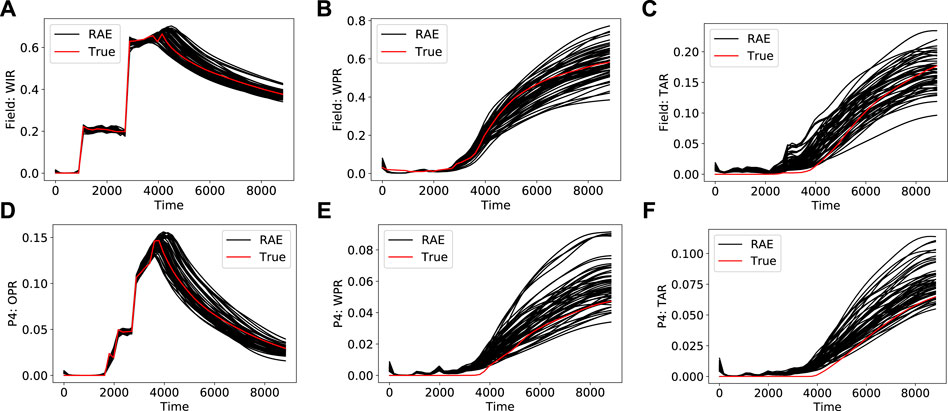
FIGURE 16. Posterior data realizations for primary quantities (A) field-wide water injection rate (B) field-wide water production rate (C) field-wide tracer A production rate (D) P4 oil production rate (E) P4 water production rate (F) P4 tracer A rate.

TABLE 1. Number of prior realizations required to construct all posterior samples for different coefficient cutoff values.
The results in Table 1 clearly indicate that DSI posterior results cannot be expressed in terms of a small number of prior data realizations that fall near the observations. It should be noted, however, that particular responses (e.g. one of the curves in Figure 16) may be represented, through use of Eq. 16, in terms of
DSI Results for Multiple True Models
In our final assessment, we construct posterior DSI results using both parameterization procedures for a set of five additional true models. For conciseness, in these results we present only a single metric, coverage probability (CP). The coverage probability is defined as the fraction of the true data that fall in a specific range of the DSI posterior results, i.e.,
where
The five new true models (denoted true models 2–6) are random realizations not included in the set of prior models, but the values of all model parameters are in the prior range (this was not the case for true model 1 considered in Sections 4.1 and 4.2). We construct posterior DSI results precisely as in Section 4.1. Results for coverage probability are presented in Figure 17. For the
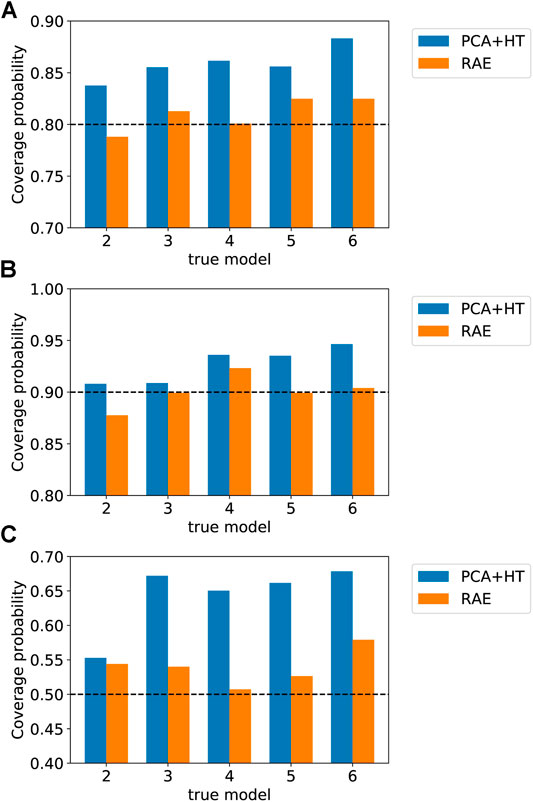
FIGURE 17. Coverage probability (CP) for five new true models (A) CP for
These results are consistent with our observation in Section 4.1 that the PCA+HT treatment generally corresponds to higher DSI posterior uncertainty. This is likely due to the fact that the PCA+HT parameterization does not fully capture correlations between different QoI. As a result, measurements for a particular quantity at a particular time may not lead to the correct level of uncertainty reduction for other quantities. Because the RAE-based parameterization better captures correlations in the data, it provides more accurate estimates for posterior uncertainty.
Concluding Remarks
In this paper, we applied recently developed data-space inversion treatments for a naturally fractured reservoir. These treatments involve the use of a recurrent autoencoder (RAE) for the parameterization of well-level and field-level time series of interest. The RAE utilizes a long short-term memory (LSTM) architecture, and the resulting network is able to capture the physical behavior and correlations in the time-series data. The overall RAE-based DSI procedure, introduced in [5], applies ESMDA for posterior sampling, as originally suggested (within a DSI context) by [4]. The examples considered in [5] were somewhat idealized, however. The (real) case considered here, by contrast, is much more complicated and includes multiple 3D fracture scenarios, three-phase flow, tracer injection and production, and detailed well and field management logic that forces frequent well shut-in and reopening. A total of 1850 prior data vectors (time series) were constructed though simulation of prior geomodels. This is the time-consuming step in DSI.
In addition to the RAE-based parameterization, we also considered the use of a parameterization based on PCA and histogram transformation [2]. We first assessed the two parameterization procedures in terms of their ability to reconstruct time-series data for realizations not included in the training set. The RAE-based parameterization outperformed the PCA-based method for these time-series reconstructions, and was shown to better capture correlations in the prior data. Superior RAE performance was observed both for primary quantities (data variables included in the data vector) and for derived quantities (which are not directly included in the data vector).
Posterior DSI results (
There are many interesting directions that should be pursued in future work. In the current RAE method, the latent space provided by the encoder is close to (but not precisely) multivariate-Gaussian distributed. It will be useful to develop and test other encoding treatments, e.g., variational autoencoder or generative adversarial network, in an attempt to achieve (precise) multi-Gaussian latent variables which, upon decoding, still provide highly accurate reconstructions of the prior data. If we are able to accomplish this, we could apply the network to provide synthetic prior data realizations; i.e., realistic data realizations, with correct correlations between data variables, that do not require numerical simulation. Further investigation of the selection of the most-relevant prior realizations, using the approach presented in Section 4.2, should also be performed. It will additionally be of interest to combine model-based inversion with data-space inversion by introducing parameterizations that couple data and model parameters. Then, by conducting data assimilation in the joint space, we could efficiently generate posterior models along with posterior data realizations.
Data Availability Statement
The datasets presented in this article are not readily available because the data are proprietary to Chevron. Inquiries regarding the data should be directed to Robin Hui, cm9iaW4uaHVpQGNoZXZyb24uY29t.
Author Contributions
SJ: Conceptualization, development of DSI and RAE methodologies, software development, generation and interpretation of DSI results, writing. M-HH: Conceptualization, generation of full-order simulation results, interpretation of results, writing. LD: Conceptualization, interpretation of results, writing and editing, funding acquisition.
Funding
Financial support was provided by Chevron Technical Center and by the industrial affiliates of the Stanford Smart Fields Consortium.
Conflict of Interest
Author M-HH is employed by Chevron Technical Center. SJ and LJD declare that they received funding from Chevron Technical Center for this study. Beyond M-HH's direct involvement as a co-author, the funder was not involved in the study design, the collection, analysis, and interpretation of data, the writing of this article, or the decision to submit it for publication.
The remaining authors declare that the research was conducted in the absence of any commercial or financial relationships that could be construed as a potential conflict of interest.
References
1. Sun, W, and Durlofsky, LJ. A New Data-Space Inversion Procedure for Efficient Uncertainty Quantification in Subsurface Flow Problems. Math Geosci (2017) 49:679–715. doi:10.1007/s11004-016-9672-8
2. Sun, W, Hui, M-H, and Durlofsky, LJ. Production Forecasting and Uncertainty Quantification for Naturally Fractured Reservoirs Using a New Data-Space Inversion Procedure. Comput Geosci (2017) 21:1443–58. doi:10.1007/s10596-017-9633-4
3. Jiang, S, Sun, W, and Durlofsky, LJ. A Data-Space Inversion Procedure for Well Control Optimization and Closed-Loop Reservoir Management. Comput Geosci (2020) 24:361–79. doi:10.1007/s10596-019-09853-4
4. Lima, MM, Emerick, AA, and Ortiz, CEP. Data-Space Inversion with Ensemble Smoother. Comput Geosci (2020) 24:1179–200. doi:10.1007/s10596-020-09933-w
5. Jiang, S, and Durlofsky, LJ. Data-Space Inversion Using a Recurrent Autoencoder for Time-Series Parameterization. Comput Geosci (2021) 25:411–32. doi:10.1007/s10596-020-10014-1
6. Scheidt, C, Renard, P, and Caers, J. Prediction-focused Subsurface Modeling: Investigating the Need for Accuracy in Flow-Based Inverse Modeling. Math Geosci (2015) 47:173–91. doi:10.1007/s11004-014-9521-6
7. Satija, A, and Caers, J. Direct Forecasting of Subsurface Flow Response from Non-linear Dynamic Data by Linear Least-Squares in Canonical Functional Principal Component Space. Adv Water Resour (2015) 77:69–81. doi:10.1016/j.advwatres.2015.01.002
8. Satija, A, Scheidt, C, Li, L, and Caers, J. Direct Forecasting of Reservoir Performance Using Production Data without History Matching. Comput Geosci (2017) 21:315–33. doi:10.1007/s10596-017-9614-7
9. Park, J, and Caers, J. Direct Forecasting of Global and Spatial Model Parameters from Dynamic Data. Comput Geosciences (2020) 143:104567. doi:10.1016/j.cageo.2020.104567
10. Jeong, H, Sun, AY, Lee, J, and Min, B. A Learning-Based Data-Driven Forecast Approach for Predicting Future Reservoir Performance. Adv Water Resour (2018) 118:95–109. doi:10.1016/j.advwatres.2018.05.015
11. He, J, Tanaka, S, Wen, XH, and Kamath, J. Rapid S-Curve Update Using Ensemble Variance Analysis with Model Validation. In: SPE Western Regional Meeting; Bakersfield, CA, United States: Society of Petroleum Engineers (2017).
12. He, J, Sun, W, and Wen, XH. Rapid Forecast Calibration Using Nonlinear Simulation Regression with Localization. In: SPE Reservoir Simulation Conference; Galveston, TX, United States: Society of Petroleum Engineers (2019).
13. Grana, D, Passos de Figueiredo, L, and Azevedo, L. Uncertainty Quantification in Bayesian Inverse Problems with Model and Data Dimension Reduction. Geophysics (2019) 84:M15–M24. doi:10.1190/geo2019-0222.1
14. Mohd Razak, S, and Jafarpour, B. Rapid Production Forecasting with Geologically-Informed Auto-Regressive Models: Application to Volve Benchmark Model. In: SPE Annual Technical Conference and ExhibitionSociety of Petroleum Engineers (2020).
15. Yang, S, Yang, D, Chen, J, and Zhao, B. Real-time Reservoir Operation Using Recurrent Neural Networks and Inflow Forecast from a Distributed Hydrological Model. J Hydrol (2019) 579:124229. doi:10.1016/j.jhydrol.2019.124229
16. Hui, MH, Dufour, G, Vitel, S, Muron, P, Tavakoli, R, Rousset, M, et al. A Robust Embedded Discrete Fracture Modeling Workflow for Simulating Complex Processes in Field-Scale Fractured Reservoirs. In: SPE Reservoir Simulation Conference; Galveston, TX, United States: Society of Petroleum Engineers (2019).
17. He, J, and Hui, M. IOR Pilot Evaluation in Brown-Field Fractured Reservoir Using Data Analytics of Reservoir Simulation Results. In: SPE Reservoir Simulation Conference; Galveston, TX, United States: Society of Petroleum Engineers (2019).
18. Hochreiter, S, and Schmidhuber, J. Long Short-Term Memory. Neural Comput (1997) 9:1735–80. doi:10.1162/neco.1997.9.8.1735
19. Kingma, DP, and Ba, J. Adam: a Method for Stochastic Optimization. arXiv (2014) [Epub ahead of print]. Available at: https://arxiv.org/abs/1412.6980.
20. Emerick, AA, and Reynolds, AC. Ensemble Smoother with Multiple Data Assimilation. Comput Geosciences (2013) 55:3–15. doi:10.1016/j.cageo.2012.03.011
21. Evensen, G. Sampling Strategies and Square Root Analysis Schemes for the EnKF. Ocean Dyn (2004) 54:539–60. doi:10.1007/s10236-004-0099-2
22. Emerick, AA, and Reynolds, AC. History Matching Time-Lapse Seismic Data Using the Ensemble Kalman Filter with Multiple Data Assimilations. Comput Geosci (2012) 16:639–59. doi:10.1007/s10596-012-9275-5
23. Glorot, X, and Bengio, Y. Understanding the Difficulty of Training Deep Feedforward Neural Networks. In: Proceedings of the Thirteenth International Conference on Artificial Intelligence and Statistics (JMLR Workshop and Conference Proceedings) (2010). p. 249–56.
24. Sun, W, and Durlofsky, LJ. Data-Space Approaches for Uncertainty Quantification of CO2 Plume Location in Geological Carbon Storage. Adv Water Resour (2019) 123:234–55. doi:10.1016/j.advwatres.2018.10.028
Keywords: data-space inversion, history matching, data assimilation, time-series parameterization, deep learning, naturally fractured reservoir
Citation: Jiang S, Hui M-H and Durlofsky LJ (2021) Data-Space Inversion With a Recurrent Autoencoder for Naturally Fractured Systems. Front. Appl. Math. Stat. 7:686754. doi: 10.3389/fams.2021.686754
Received: 27 March 2021; Accepted: 11 June 2021;
Published: 12 July 2021.
Edited by:
Alexandre Anozé Emerick, Petrobras, BrazilReviewed by:
Ahmed H. Elsheikh, Heriot-Watt University, United KingdomYuguang Wang, Shanghai Jiao Tong University, China
Smith Washington A. Canchumuni, Pontifical Catholic University of Rio de Janeiro, Brazil
Copyright © 2021 Jiang, Hui and Durlofsky. This is an open-access article distributed under the terms of the Creative Commons Attribution License (CC BY). The use, distribution or reproduction in other forums is permitted, provided the original author(s) and the copyright owner(s) are credited and that the original publication in this journal is cited, in accordance with accepted academic practice. No use, distribution or reproduction is permitted which does not comply with these terms.
*Correspondence: Su Jiang, c3VqaWFuZ0BzdGFuZm9yZC5lZHU=
 Su Jiang
Su Jiang Mun-Hong Hui
Mun-Hong Hui Louis J. Durlofsky1
Louis J. Durlofsky1